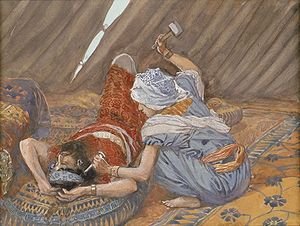by Kathy Brasby | Jun 28, 2013 | Hope
A woman killing a military hero makes for an unexpected story and Jael’s grisly slaying in the book of Judges contains an striking motif that uses vivid images to make the story spring to life.

English: Jael Smote Sisera, and Slew Him, circa 1896-1902, by James Jacques Joseph Tissot (French, 1836-1902) or follower, gouache on board, 5 7/16 x 7 3/8 in. (13.9 x 18.8 cm), at the Jewish Museum, New York (Photo credit: Wikipedia)
The account of Jael and Sisera takes place within the story of Deborah, a judge of Israel who led a great victory over the army of Jabin, king of Canaan, lead by Sisera.
Sisera’s army is routed in spite of its superiority and Sisera flees on foot, with Barak, the Israelite general, in pursuit. Sisera flees to the tent of Jael, assuming to find sanctuary because of the peace between Jabin and Jael’s husband, Heber.
A nurturing, maternal motif forms in the story. Jael is first seen in her tent and comes out to invite Sisera in. Twice she calls him to “turn aside” and tells him to have no fear. The tent, as the woman’s domain, can be seen as a womb. In inviting Sisera to enter, there is a sense of protection as a baby in a womb.
That imagery continues as she covers Sisera with a rug as a mother might cover a baby. He asks her for a drink of water like a child might ask its mother. Jael, however, gives Sisera milk – more than he asked for and more comforting – and then covers him again, evoking further images of a mother and baby.
Sisera asks Jael to stand guard at the door of the tent and tell any men, “There is no man within.” From Sisera’s point of view, he has commanded her to protect him by lying, confident in his military authority. But Sisera has figuratively regressed from manhood to childhood in blindly trusting Jael; there really is no man within the tent.
Sisera sleeps like a baby, for although he has the leader of the opposition chasing him, he is able to trust Jael enough to sleep.
She takes up the hammer and tent peg – tools of a woman in that culture because they were the ones who moved the tents– and goes quietly to him like a mother tiptoeing to her child’s bedside to check his breathing while he sleeps.
However, the story violently twists and Jael drives the peg into Sisera’s head, killing him.
Jael is a hero to her people and yet the imagery makes us squeamish. We grapple with the motif twisted. How could a mother betray her baby? Why did Sisera relinquish his trust and his life to this woman?
Striking use of imagery makes Jael’s story a powerful one with many questions to be explored.
Like this:
Like Loading...
by Kathy Brasby | Jun 24, 2013 | Hope
This puppet show was not supposed to happen.

(Photo credit: Wikipedia)
After traveling over 1200 miles to work for a small church in Mexico, including preparing a 30-minute puppet performance for their children, I was bedridden with the flu and a 102-degree temperature all week.
Fortunately I was part of a team that worked without me but I was in charge of the puppet show.
By Sunday morning, when the performance was planned, I felt well enough to help prepare the props and set up our stage.
And then two of our teenage puppeteers approached us, faces like a birthday child with no gifts. “We just found out that Mary bought drug paraphernalia this week and tried to hide it in Teresa’s suit case.”
What do you say to that?
Mary had joined our team at the last minute and no one knew her very well. We just hadn’t realized how un-well we knew her. I envisioned a church team getting busted at the border for paraphernalia possession – and sweet Teresa getting the blame.
Nothing like a little distraction when you’re trying to put a performance together.
We drew in a team breath – no easy task when half the team was still hyperventilating over Mary’s deception – and continued on. The props were ready, puppets laid about, puppeteers ready – and the electricity went out. We needed electricity for our music.
Power outages, we learned, were not uncommon in this neighborhood. Why hadn’t we packed batteries for the CD player? For the same reason we had let Mary join the team. Not thinking well.
We dispatched someone to buy batteries. He returned with four D batteries purchased for $20, which was highway robbery, and we punched them into our player. We then found out what highway robbery really is: buying batteries that were dead for $20.
So my innovative husband threw himself into building an adapter that would run the CD player off a car battery. Visualize that. The car battery was bigger than the CD player.
He stripped wires and taped ends together. Five minutes before the performance time, he gave me a thumbs up.
And then the electricity came on.
We completed the show and then the lights went out again.
But the audience applauded our show and several came forward with questions and commitments for the pastor.
In spite of the flu, Mary the paraphernalia smuggler, and power issues, the puppet show that couldn’t happen did happen. And with a resounding “yes!”
Perseverance matters.
Like this:
Like Loading...
by Kathy Brasby | Jun 21, 2013 | Hope
Although Esther in the Old Testament has a book named after her, the Bible portrays her as a hero who didn’t start out that way.
The book of Esther relates how the Jewish people, under a genocide order by a duped Persian king, were saved by insomnia and a reluctant queen.
Often we see Esther as a brave hero – and she was in the end. But her transformation is part of the story. She didn’t start out a hero.
Instead, she became queen through a king of beauty contest, at her uncle’s wish.
Her uncle, Mordecai, is the hero of this story and Esther is the person transformed. Mordecai was courageous and concerned about others. Not only did he want to protect the Jews, but he saved the king’s life at one point.
Esther, once brought into the king’s palace, remained rather anonymous. The court people did not realize she was a Jew, which indicates that she probably did not hold to a kosher lifestyle. When the news of the order against the Jews came to her ears, she didn’t do anything.
Mordecai prompted her to approach the king and she, at first, hesitated. When she learned of Mordecai in sackcloth, she told him to stop mourning.
But then she learned of her people’s problem and she, in an amazing character transformation, grasped her destiny.
When Esther decided to act, she revealed the courage and character that she needed to complete her destiny. But she didn’t step forward in giddy confidence. “If I perish, I perish,” she told Mordecai.
God is never mentioned in the book of Esther. Even when Esther asks for “fasting,” we wonder why she didn’t ask for “prayer and fasting.”
But the providential events – from a shy but beautiful Jewish girl being selected as queen of Persia to a king who couldn’t sleep and instead was reminded of Mordecai’s kindness to him – signal something amazing going on behind the scenes.
In our storytelling economy, we would have placed the brave and wise Mordecai in a position to save the people. We would not have chosen a quiet queen content to hide.
(Esther’s name in Hebrew could be Mistar, related to mystery and similar to I am hidden.)
Yet this non-hero stepped up when called upon, providing victory and salvation to the Jews.
The Bible relates the stories of non-heroes with stunning results.
Like this:
Like Loading...
by Kathy Brasby | Jun 19, 2013 | Stories
I knew things were going to get a little sticky when I uncovered an ink refill for a printer that I don’t remember owning. I had to crack open my archive box and I was finding interesting treasures.
pochette CD.jpg (Photo credit: Wikipedia)
“Archive box” sounds fancy, doesn’t it?
My archive box is a plastic box with lid that contains CDs from programs I’ve installed. What a great idea, I thought when I got it. All my CDs were safely stored in one place and protected from dust and stuff.
I don’t know why the ink refill was in the box. The printer must not have lasted long enough to even earn a refill.
I don’t visit my archive box much but my computer crashed and I was re-installing programs.
But opening that box was like a trip down memory lane but without the warm fuzzy emotions. What I felt was confusion.
For example, I uncovered a CD with a big black question mark scrawled on the label.
What in the world? Who labels their CD with a question mark?
Me, obviously.
Although nobody accuses me of being well-organized (well, someone did once but that was before they saw my desk), I took some pride on my box as a shred of planning.
Every program CD went into that box after installation.
I am proud to say that there were no 5 1/4 inch floppies in there. Using my system, that’s a miracle.
So I started flipping through CD jewel boxes for programs to reinstall.
I found programs that won’t run on anything newer than Windows 98. I found programs for pre-schoolers. (Our youngest is 17.) I found a CD from our classical music days.
I’d like to blame this on the kids but they never open the box. They just run the programs and don’t mess with the details.
Wonder where they learned that?
I’m sure there’s a major life lesson in all this. Something about staying organized but those lessons tend to roll off me like tumbleweeds crossing the prairie.
Sometimes simple is better. So here’s what I learned: I’m cleaning out the box.
That way there’ll be room for further archiving.
Like this:
Like Loading...
by Kathy Brasby | Jun 17, 2013 | Hope
I know you know where chocolate milk comes from and that red cows don’t produce strawberry shakes.

Cow Holstein (Photo credit: Wikipedia)
But rural people often laugh at the misconceptions that non-rural people have. Some of the simpler wrong notions include the idea that black cows give chocolate milk or that bulls have horns and cows don’t.
And it is frustrating to hear people comment that we don’t need to have all those dairy cows because people can get their milk from Safeway instead.
I once had a college roommate mock me because I didn’t know that buttermilk came from stirring melting butter into milk. The fact that I had seen buttermilk in the actual making of butter in a churn didn’t impact her at all.
But one of my favorite stories came when a non-rural family came to visit.
“Can we come over this evening and watch you milk your goats?” This phone call came from our neighbor who had weekend guests wanting to experience some rural flavor.
So they came. The neighbor brought a dad with two teenage boys. The dad, Jim, had experienced a slice of farm life from his days visiting his grandparents on their farm. So this was warm nostalgia for him.
Not so much for the teenage boys.
They were willing to wander around outside pestering the ducks before Dad ordered them into the milking room.
“This is cool,” he said. “Get in here and watch.”
So I milked and answered questions from Jim while the boys leaned against the far wall with their hands in their pockets. Then they all went home.
My neighbor called me the next morning. “Jim said thanks for letting them come over.” And she laughed. “And the boys came back here to announce that, after seeing where milk came from, they are never drinking milk again.”
“Whew,” I said. “Good thing they don’t know where eggs come from, then. They might never eat again.”
Like this:
Like Loading...



